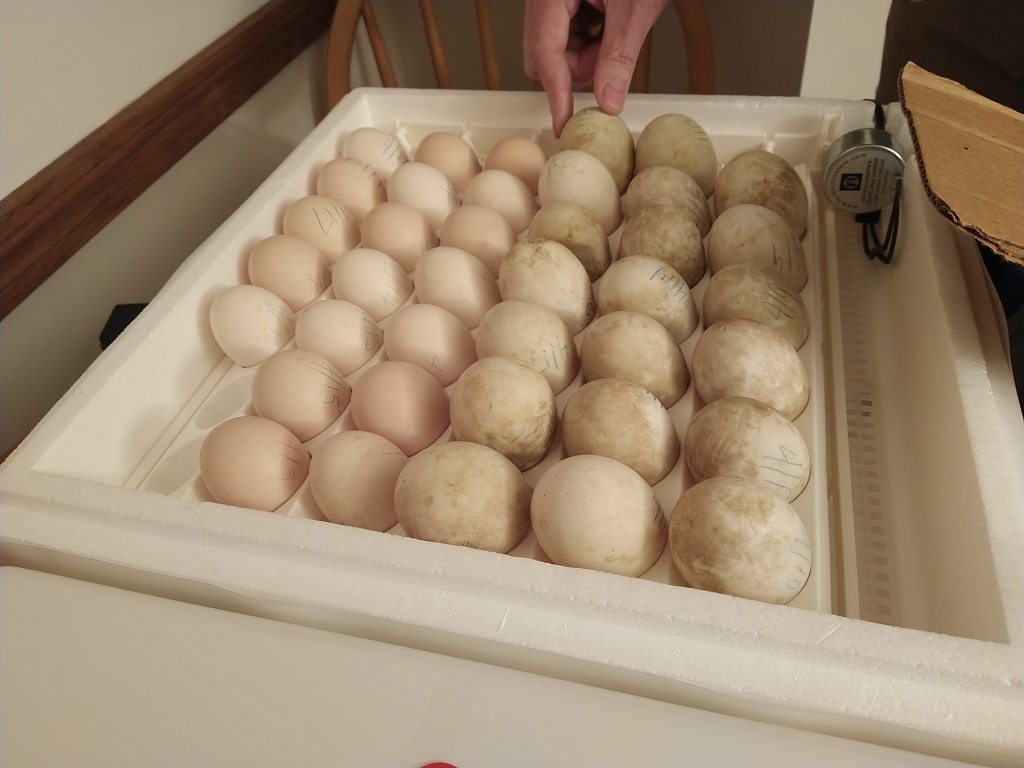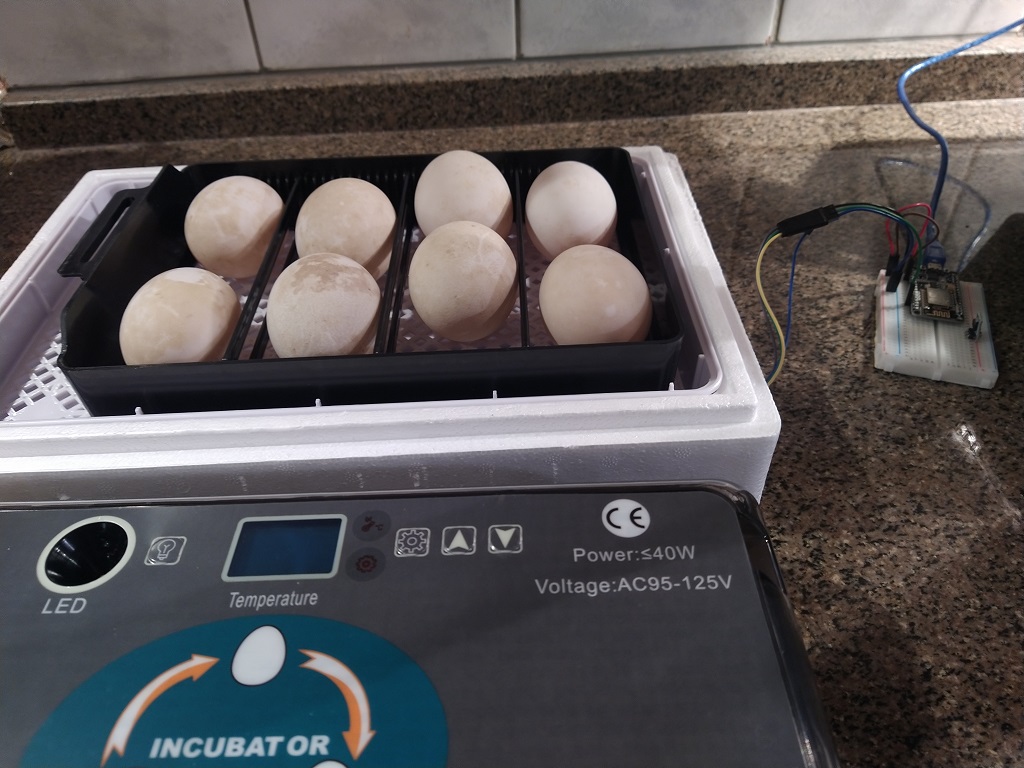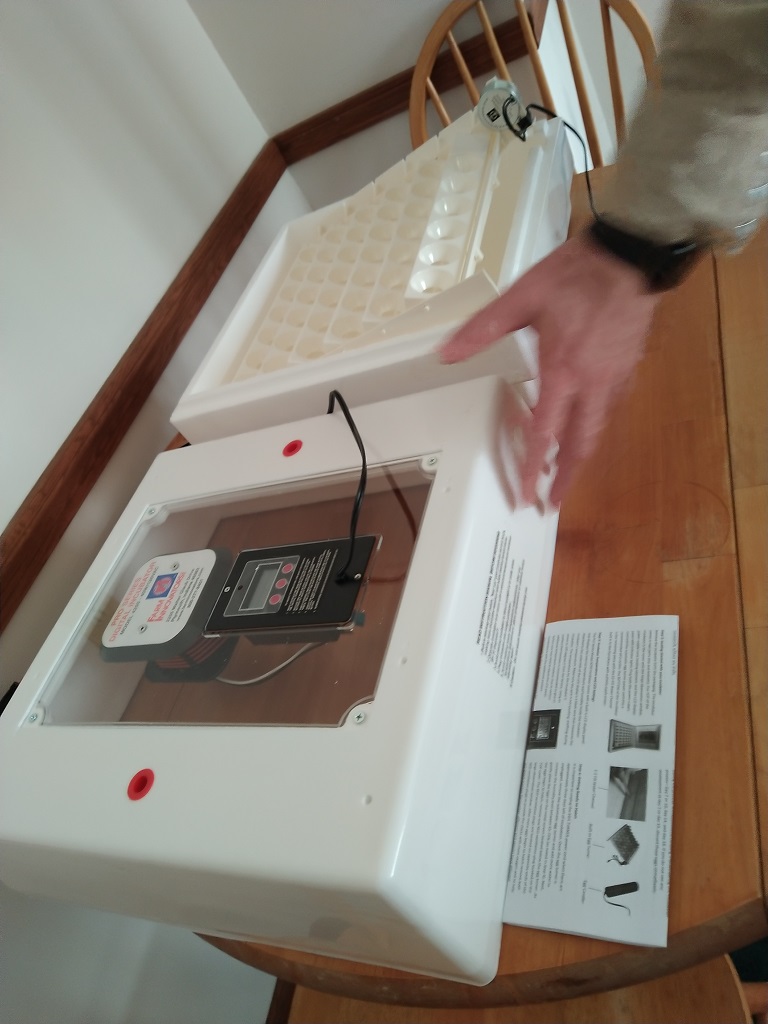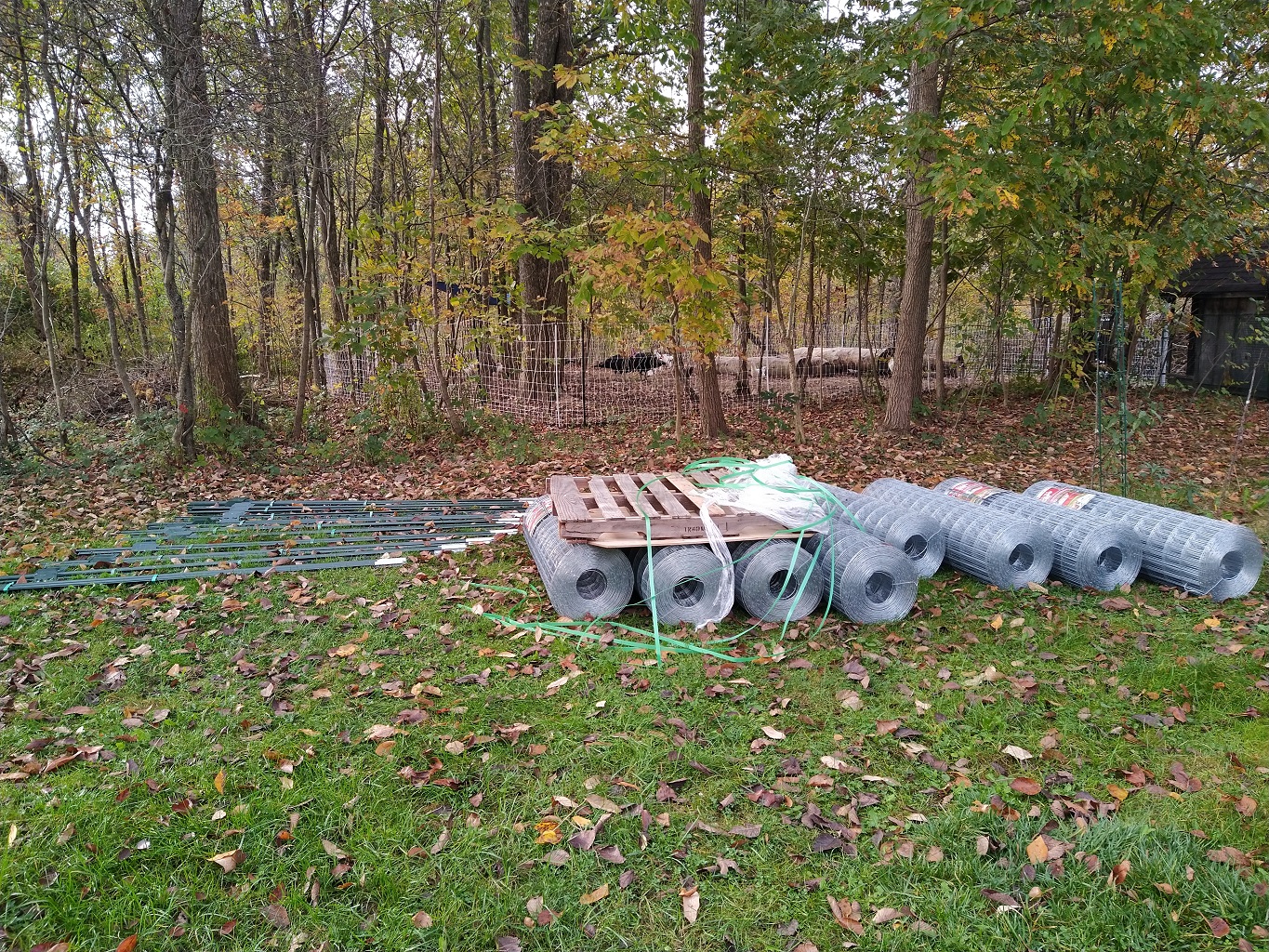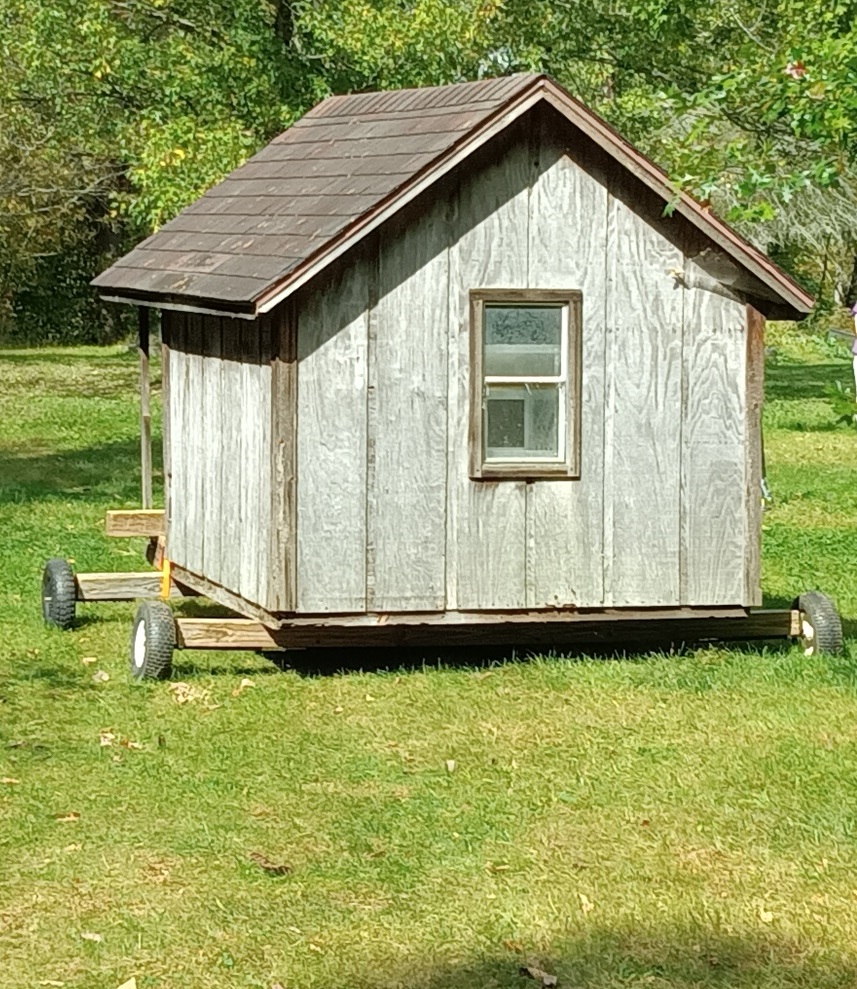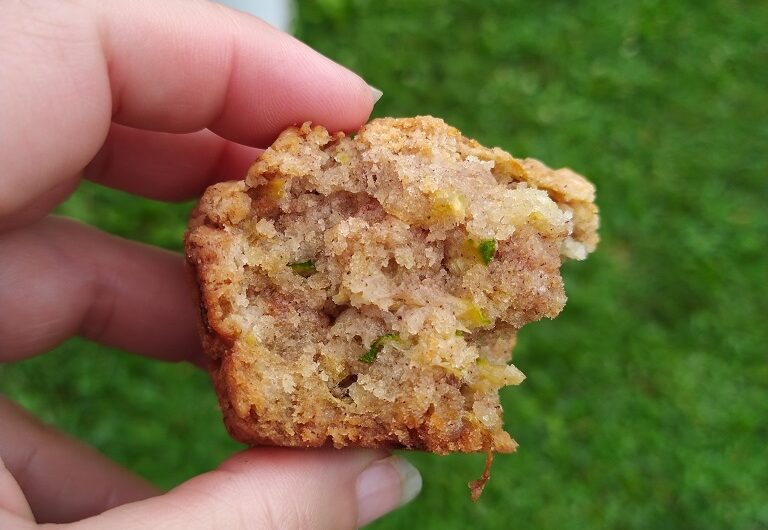Trying again with the bigger, better incubator — 22 duck eggs and 19 chicken eggs.
Category: Chickens
Farm Automation
Scott set up one of the ESP32’s that we use as environmental sensors to monitor the incubator. There’s an audible alarm if it gets too warm or cold, but that’s only useful if you’re pretty close to the unit. We had gotten a cheap rectangular incubator from Amazon — it’s got some quirks. The display says C, but if we’ve got eggs in a box that’s 100C? They’d be cooked. The number is F, but the letter “C” follows it … there’s supposed to be a calibration menu option, but there isn’t. Worse, though — the temperature sensor is off by a few degrees. If calibration was an option, that wouldn’t be a big deal … but the only way we’re able to get the device over 97F is by taping the temperature probe up to the top of the unit.
So we’ve got an DHT11 sensor inside of the incubator and the ESP32 sends temperature and humidity readings over MQTT to OpenHAB. There are text and audio alerts if the temperature or humidity aren’t in the “good” window. This means you can be out in the yard or away from home and still know if there’s a problem (since data is stored in a database table, we can even chart out the temperature or humidity across the entire incubation period).
We also bought a larger incubator for the chicken eggs — and there’s a new ESP32 and sensor in the larger incubator.
Incubators
We tried a cheap forced-air incubator from Amazon.
All of these little rectangular boxes seem to have the same design flaw: the fan and heater are in one corner of the incubator, and the hot air blows out of one side of the box. So there are really hot spots in the incubator and relatively cold spots.
Since we had a bad hatch rate (1 of 8) with the thing, we decided to get a bigger, better incubator. After researching a lot of options, we got the Farm Innovators 4250 — lots of space for eggs, a centrally located heater and fan that blow air all around, and a humidity sensor (looks to be the same DHT-11 that we use in our sensor). We’ll collect eggs and get a large batch going in a few weeks.
Incubating Eggs
We’re about to start incubating eight duck eggs, so I wanted to record the temperature and humidity settings that I’ve found for the chicken, duck, and turkey eggs (well, future turkey eggs! We managed to get five male turkeys last year)
| DUCKS | |||
| Start | End | Temp | Humidity |
| 1 | 25 | 99.5 | 55-58% |
| 26 | 28 | 98.5 | 65% |
| 28 | hatching | 97 | 70-80% |
| CHICKENS | |||
| Start | End | Temp | Humidity |
| 1 | 18 | 99.5-100.5 | 45-55% |
| 19 | Hatching | 99.5 | 65-70% |
| TURKEYS | |||
| Start | End | Temp | Humidity |
| 1 | 24 | 99-100 | 50-60% |
| 25 | Hatching | 99 | 65-70% |
Starplates & Chicken Coop
We were finally able to get the starplates to build a 1V geodesic dome for the new chicken coop. Super excited — and we’re going to have a lot of construction going on this year. A greenhouse tunnel for extending the growing season, a chicken coop, a duck coop, a pig shelter, and hopefully a sheep shelter too.
Spatchcock butchering method
We butchered our broilers and ducks for the year. In a larger household, a whole bird is probably a perfectly reasonable amount of food. But, for us? It’s too much food. Half a bird is a lot more reasonable.
In looking at techniques for grilling and smoking poultry, we came across spatchcocking — basically splitting the whole bird along the spine so it lays flat. It looked like a much quicker way to butcher — and, if we didn’t want to have a whole bird in the end anyway it isn’t like the approach would be counterproductive.
So we’ve been butchering by detaching the crop, airway, and throat. Placing the bird so the backbone is up and the neck facing you, cut along the spine. It’s a little tricky to cut at the hip joint — you’ve got to find the right spot to snip, but the oyster is always included with the leg using this method — and be careful not to pierce intestines. You can leave the spine with one half or cut down the other side of the spine. Cut around the vent, then clear out all of the innards — one entire mass is removed. Either finish spatchcocking to store a whole bird or use shears to cut along the breastbone and have two halves. I’ve found this approach to be a lot quicker than the normal technique — and, since the carcass is open, removing the innards is very easy.
Fence Stuff
Coop Mobile, Take 2
We set up the coop mobile again — I got one of the PoultryNet fences from PremierOne — I spent a lot of time debating the “Plus” version of the fence before realizing that you could buy a whole lot of the FiberTuff posts for less than the additional price for the plus fence. And the FiberTuff posts work a lot better. Since the fence was working well, we decided to move the coop over to the pasture (and not herd the poultry across the yard twice a day!!!).
The “wheels” were made using two 4×4’s with sections of 5/8″ threaded rod that were inserted into old propane tube. This was attached to the 4×4 & wheels from one of our yard carts were attached. We were then able to push the coop across the yard.
Chicken Birthday Cake
Chicken Birthday cake
Course: DessertCuisine: AmericanDifficulty: Easy12
servings30
minutes50
minutesIngredients
1 cup coconut oil
3 eggs
1/2 cup sugar
2 cups whole wheat flour
1 cup all purpose flour
2 tsp cinnamon
1 tsp baking soda
1/2 tsp cream of tartar
2 cups wet grated zucchini
1/4 c sugar
1 tsp cinnamon
1/4 tsp cream of tartar
Method
- Preheat oven to 350F
- Melt coconut oil, mix in eggs.
- In a separate bowl, whisk together flours, cinnamon, baking soda, and cream of tartar
- Add the dry ingredients to the wet ingredients and mix until combined.
- Mix in zucchini.
- Add batter to muffin tins for chickens. Then mix sugar into remaining batter.
- Mix together the topping ingredients (sugar, cinnamon, cream of tartar). Partially fill remaining muffin tins. Sprinkle n topping, then fill the rest of the way and sprinkle topping again.
- Bake for 40-60 minutes until a knife inserted into the center comes out clean.
- Remove from muffin tins and allow to cool.
Our first chickens turned one year old on Tuesday, so I came up with a recipe for a “chicken birthday cake” that would be healthy(ish) for chickens and tasty for us. Leaving the sugar out of the batter worked well — the chickens got whole wheat, coconut oil, cinnamon, and zucchini. We got cake — and the topping mixture gave the muffins a crispy and crunchy top. Would totally make this again.
Chicken Chaos
Well … we had one day of Astra fostering the new broilers. They’re older baby guys (which is why they were super cheap) … and I think they got used to doing their own thing. And didn’t want to get back into the nesting box when she told them to. The OG baby guy totally comes when called, but these guys? Not so much. And Astra freaked out. Anya saved one of the Cornish babies while Scott and I were working on some trees — she got Astra out of the coop and tended to the little guy’s wounded head. It was bad — scalped. She tried putting Astra in the tractor with the other birds, but Astra was pretty set on getting back to baby guy. And freaked out the turkeys, who attacked her. So now Astra has the feathers pulled from the back of her head just like the Cornish she attacked.
Anya got Astra into the baby tractor, got the turkeys calmed down, and introduced the Cornish to the ducks (who, thankfully, didn’t go after the wound). Baby guy made its way out of the coop and over to Astra in the baby tractor. So they were happy, pecking around at food and grit. The Cornish were safe in the coop. And everyone else was in the big tractor. That was sorted enough that we could finish splitting the wood and getting it stacked.
Near sunset, we had to get all of the Cornish into the brooder so Astra and baby guy could go into the coop. We put a board in front of their nesting box to keep the turkeys from going after her wounded head.
